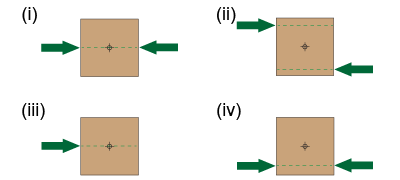Match each word to the sentence where it best fits.
| torque | | line of action | | lever | | fulcrum | |
- A _______ is a simple machine that uses torque to multiply linear forces.
- The point about which a lever rotates is the _______.
- _______ is measured in units of newton meters.
- The _______ goes through an object and points where a force goes.
| safety factor | | tensile strength | | stress | |
- If the applied force per unit area exceeds a material’s _______, then it may break.
- An engineer was tasked to design a footbridge to support a load of 5000 N, so he designed it to withstand a force of 50,000 N instead to account for a _______ of 10.
- The amount of applied force per unit area is the _______ on the material.
- Ask two friends if they can find the difference in the following two statements.
Statement 1: “A torque results from a force applied in a way that could cause an object to rotate.”
Statement 2: “A torque is the result of an object’s rotation under the action of a force.”
Which one is more correct? Write down their answers. How do they compare with your own answer?
- Which sentence comes closest to the meaning of the following equation?
- The product of all forces equals zero.
- The sum of all forces equals zero independently in every direction.
| | - Julietta claims that an object in rotational equilibrium cannot spin. Javier disagrees and says that an object in rotational equilibrium can spin. Who is right, and why?
- Describe a situation in which a force is applied that results in zero torque.
- Michael wishes to loosen a bolt and is holding a wrench that is attached to the bolt. Which of the following changes would enable him to exert a greater torque? (More than one choice may be correct.)
- using a wrench with a longer handle
- applying a lubricant to the bolt
- pushing or pulling harder on the wrench
- You are designing a see-saw (teeter-totter) for a playground. Which kind of equilibrium should the see-saw always maintain: force equilibrium, rotational equilibrium, both, or neither?

- Each of the forces shown here (as arrows) acts upon the block with a strength of 100 N. The center of rotation and line(s) of action are shown in each scenario.
- Which of the four scenarios (i, ii, iii, or iv) shows the block in force equilibrium? (More than one may be correct.)
- Which of the four scenarios (i, ii, iii, or iv) shows the block in rotational equilibrium? (More than one may be correct.)
- Which of the two following statements do you agree with? Write down your answer and explain your reasoning.
Statement 1: “Engineering is a kind of science, and that means there is always a single right answer to a problem.”
Statement 2: “Engineering is different from science. In science, a problem has just one right answer, but in engineering there might be several good solutions.”
Then ask two friends which statement each of them agrees with and why. Record their answers and compare them with your own.
- The number known as a safety factor is never assigned a value less than one. Why?
|

